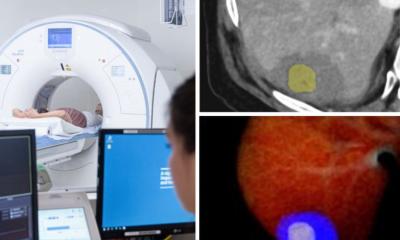The Southampton Traffic Light test
Doctors aim to spot hidden liver fibrosis and cirrhosis far sooner

Dr Nick Sheron and colleagues at the University of Southampton and Southampton General Hospital hope to use a test they are developing for the earlier identification of people in need of hospital treatment from liver disease – a condition that develops silently and presents late, often with fatal complications. The team also hopes it will help reduce unnecessary hospital referrals.
The Southampton Traffic Light (STL) test combines several different tests and clinical markers, which are given a score that indicates the patient’s likelihood of developing liver fibrosis and cirrhosis. A simple algorithm transforms this into a red, amber or green rating: red means the patient has liver fibrosis and may even have cirrhosis; green suggests there is no cirrhosis, and amber indicates at least a 50:50 chance of scarring with a significant possibility of death within five years, and patients are advised to stop drinking to avoid further disease.
The test is part of the Alcohol and Liver Disease Detection Study (ALDDeS) and comes at a time that liver disease mortality in the UK has doubled over the last 15 years, with 25% of the population drink ing above recommended guidelines. Additionally, many patients are arriving at hospital liver clinics for the first time with liver disease that has been entirely unsuspected and sometimes with end-stage liver disease – and liver disease survival rates have not improved in the last 15 years. Dr Sheron, who heads Clinical Hepatology at the University of Southampton and is consultant hepatologist at Southampton General Hospital, said that while altering people’s behaviour by reducing alcohol intake was important, the ability to go out into the community to detect people with liver disease and reach them before they develop end-stage liver disease is also crucial. Historically, liver disease diagnosis relied on referral to specialist services, often based on an elevated level of alanine transaminase (ALT), he said, but such tests were of little help in predicting which patients have liver fibrosis or cirrhosis. ‘As a result, from about the year 2000, we’ve been trying to find a test that would reflect the scarring process and would enable us to detect liver disease earlier.’
The aim was to develop a liver disease ‘traffic light’ suitable for community use to enhance liver risk assessment and allow rational referral of more severe disease to specialist care. That led to the use of fibrosis markers (procollagen-3 N-terminal peptide [P3NP] and hyaluronic acid) along with routine liver function tests to create the Southampton Traffic Light test. In trials the test, from a routine blood sample, was given to over 1,000 patients and proved to be accurate in severe liver disease detection. It was also shown to provide GPs with an objective means to accurately assess the potential severity of liver fibrosis in high-risk patients such as heavy drinkers, type II diabetics, or obese people.
As part of on-going research, the Local Care and Treatment Evaluation (LOCATE) study funded by the British Liver Trust, aims to further assess the test in primary care settings but Dr Sheron said there are clear benefits for hospitals too. ‘A large number of referrals to hospital liver clinics are completely unnecessary and patients with fatty liver disease but no underlying fibrosis could manage their condition in the community,’ he added. ‘The test would reduce unnecessary referrals but also increase necessary referrals and lead to a reduction in the number of people developing liver disease.’
Professor Sir Ian Gilmore, chair of the Alcohol Health Alliance, said the work of Dr Sheron and his colleagues ‘may prove really useful for guiding the right patients towards specialist care in a timely way’.
Dr Nick Sheron, Head of Clinical Hepatology at the University of Southampton and liver unit at Southampton General Hospital, is involved in a clinically based research programme on various aspects of alcohol-related problems. With Royal College of Physicians President Sir Ian Gilmore, he co-founded the Alcohol Health Alliance, consisting of 27 organisations including Royal Colleges, NGOs and charities, to lobby for evidence-based policies to reduce alcohol-related harm in the UK. He is also a founder member of the European Union Alcohol Forum and an Adviser to the House of Commons Health Select Committee on Alcohol.
02.11.2012







